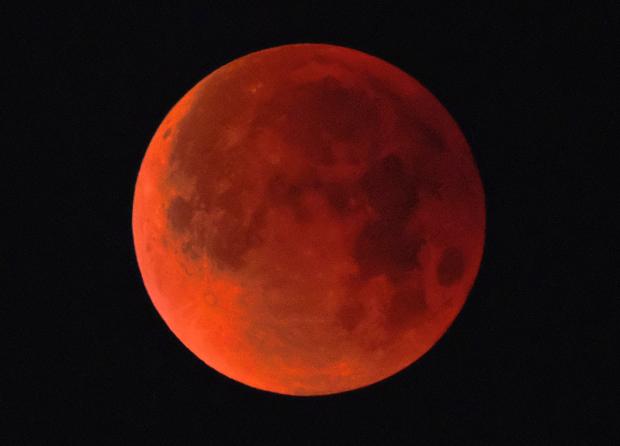
A super blue blood moon is seen over Los Angeles on Wednesday, Jan. 31, 2018. AP
As the super blue blood moon on Wednesday night awed spectators worldwide, astronomy experts and enthusiasts also saw the lunar event as a spark that would encourage more Filipinos, particularly the youth, to set their eyes on the skies and develop a stronger interest in science.
Specialists from the Philippine Atmospheric, Geophysical and Astronomical Services Administration (Pagasa) told the Inquirer that they were “overwhelmed” by the public’s response to the rare lunar show.
As the sun began to set on Wednesday, people flocked to several locations across the country where observation stations were set up. Over a thousand stargazers from all ages trooped to the Pagasa Astronomical Observatory inside the University of the Philippines (UP) campus in Diliman, Quezon City, where telescopes were made available for free.
Largest turnout
Mario Raymundo, chief of the Pagasa Astronomical Observation and Time Service Unit, described the crowd as the largest turnout at the observatory in recent years. Families, couples and groups of friends laid out their mats on the grassy hill outside, with the observatory’s roof deck spilling with enthusiasts, photographers and amateurs alike.
“The reality is that our fellow Filipinos are thirsty for knowledge when it comes to science, especially astronomy … In elementary and high school subjects, the field is discussed very briefly,” he said in an interview.
“Their knowledge is very limited … So during these events, people get amazed because they get to witness firsthand what they read in textbooks,” he added.
Raymundo said the rare astronomical show can also pique the youth’s curiosity in science, particularly in the field of astronomy.
Lunar events
Stargazers were treated to three simultaneous lunar events on Wednesday: the blue moon, supermoon and lunar eclipse. Pagasa said the astronomical trifecta was last seen in the Philippines on Dec. 30, 1982.
The blue moon refers to the second full moon of the month, while the supermoon happens when it comes within at least 361,000 kilometers from the Earth, making it appear larger and brighter than usual.
The lunar eclipse began at 6:51 p.m. and reached its peak at 9:29 p.m. Viewers were treated to a copper-colored moon for an hour and 16 minutes, from 8:51 p.m. to 10:07 p.m.
Crowd
At the Pagasa observatory, the bustling crowd cheered as the moon was slowly covered by the Earth’s shadow and clapped as it turned completely red.
Dario dela Cruz, chief of the Pagasa Space Sciences and Astronomy Section, also hoped more Filipinos would express interest in studying the planets and stars.
He said the state weather bureau had rolled out mobile planetariums in the provinces through their regional offices. With mobile telescopes and equipment onboard, people from the countryside can learn more about heavenly bodies.
Planetarium proposal
“There is also a proposal to build planetariums in the Visayas and in Mindanao,” Dela Cruz said. “There, they can learn about the basics of astronomy to encourage them to study the field even more.”
The Pagasa planetarium is located along Agham Road, also in Quezon City. The National Museum Planetarium in Manila, meanwhile, had reopened last year.
Stephanie Vergara, overall coordinator of the UP Astronomical Society, said the public’s overwhelming response to the lunar event also addressed the misconception that only those with backgrounds in the scientific field can appreciate astronomy.
“More than appreciation, Filipinos already have specific contributions in the field of astronomy, such as the Diwata-1,” she said, referring to the microsatellite built and designed by Filipinos and launched to the International Space Station in March 2016.
“I think the super blue blood moon may be the spark we were looking for to ignite the Filipinos’ enthusiasm for astronomy,” Vergara added.